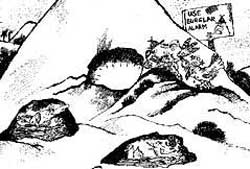Who ate my house?
 rampant harvesting of nests has caused a decline in the populations of the Edible-nest Swiftlet ( Collocalia fuciphagia ), according to R Sankaran, scientist in the division of ecology at the Salim Ali Centre for Ornithology and Natural History ( sacon ) in Coimbatore, Tamil Nadu. Sankaran has undertaken a study to assess the impact of nest collection on the swiftlet's population. In India, the bird is found only in the Andaman and Nicobar Islands. Its nests are edible, and one of the most expensive animal products in the world. The species is not included in the Convention on International Trade in Endangered Species of Wild Fauna and Flora ( cites ). This means that international trade in its nests cannot be checked easily.
rampant harvesting of nests has caused a decline in the populations of the Edible-nest Swiftlet ( Collocalia fuciphagia ), according to R Sankaran, scientist in the division of ecology at the Salim Ali Centre for Ornithology and Natural History ( sacon ) in Coimbatore, Tamil Nadu. Sankaran has undertaken a study to assess the impact of nest collection on the swiftlet's population. In India, the bird is found only in the Andaman and Nicobar Islands. Its nests are edible, and one of the most expensive animal products in the world. The species is not included in the Convention on International Trade in Endangered Species of Wild Fauna and Flora ( cites ). This means that international trade in its nests cannot be checked easily.
The nest of the swiftlet is a delicacy that dates back to antiquity. It gained commercial importance in the 16th century, when the Chinese began to value the culinary delicacy of the bird's nest soup. The demand has grown steadily, and the swiftlet has suffered
Related Content
- Judgment of the National Green Tribunal regarding plywood factories operating in Yamuna Nagar, Haryana, 27/05/2025
- Judgment of the Supreme Court regarding forest land allotted illegally to private entities, 15/05/2025
- Order of the High Court of Gujarat regarding illegal encroachments in and around Chandola lake, Ahmedabad, Gujarat, 06/05/2025
- Order of the National Green Tribunal regarding illegal felling of trees by a real estate company in Delhi, 05/05/2025
- Order of the Supreme Court regarding construction of houses in forest area, Madhya Pradesh, 29/04/2025
- Order of the National Green Tribunal regarding township construction on the Yamuna river bed, Noida, Gautam Buddh Nagar, Uttar Pradesh, 21/04/2025
